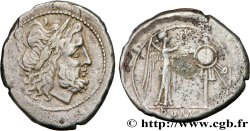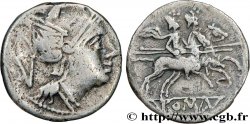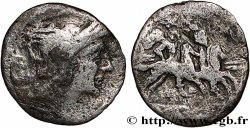brm_746366 - ROMAN REPUBLIC - ANONYMOUS Denier Serratus
Not available.
Item sold on our e-shop (2022)
Price : 550.00 €
Item sold on our e-shop (2022)
Price : 550.00 €
Type : Denier Serratus
Date: c. 209-208 AC.
Mint name / Town : Sicile
Metal : silver
Millesimal fineness : 950 ‰
Diameter : 19 mm
Orientation dies : 3 h.
Weight : 3,87 g.
Rarity : R2
Coments on the condition:
Exemplaire sur un flan ovale décentré au droit avec les grènetis visibles. Très beau portrait de Rome de style fin, bien venu à la frappe. Revers de haut relief, finement détaillé. Belle patine avec des reflets dorés. Conserve la plus grande partie de son brillant de frappe et de son coupant d’origine
Catalogue references :
Obverse
Obverse legend : ANÉPIGRAPHE.
Obverse description : Tête casquée de Rome à droite ; derrière X.
Reverse
Reverse legend : ROMA EN RELIEF À L'EXERGUE.
Reverse description : Les Dioscures, Castor et Pollux (les Gémeaux) à cheval, galopant à droite, nus avec le manteau flottant sur l'épaule, coiffés d'un bonnet surmonté d'une étoile, tenant chacun une javeline ; une roue à six rais sous les chevaux.
Reverse translation : “Roma”, (Rome).
Commentary
Poids léger. Pour ce type, M. Crawford a relevé une estimation de quarante coins de droit et de cinquante coins de revers. Ce denier est en fait plus rare que ne le laissent paraître les différents ouvrages généraux. Pour ce type il y a deux datations possibles, en 209-208 et beaucoup plus tard. D’après M. Crawford, nous serions bien en présence d’un denier frappé vers 209-208 avant J.-C. en Sicile. Notons au passage que ce denier semble serratus. Pour cette émission, nous n’avons que le denier. Nous pourrions avoir affaire à une autre théorie que ce denier est en fait frappé beaucoup plus tard à la fin du Ier siècle avant J.-C. avec la véritable marque de valeur au revers placée dans la roue (16 as) et le fait que le denier soit dentelé. L’exemplaire de MONNAIES 52, n° 31 s’est vendu 590€ avec neuf offres sur un maximum à 660€.
Light weight. For this type, Mr. Crawford noted an estimate of forty obverse dies and fifty reverse dies. This denarius is actually rarer than the various general works suggest. For this type there are two possible dates, in 209-208 and much later. According to Mr. Crawford, we would indeed be in the presence of a denarius struck around 209-208 BC in Sicily. Note in passing that this denarius seems serratus. For this issue, we only have the denarius. We could be dealing with another theory that this denarius was in fact struck much later at the end of the 1st century BC with the true value mark on the reverse placed in the wheel (16 aces) and the fact that the denarius is perforated. The copy from COINS 52, No. 31 sold for €590 with nine bids out of a maximum of €660
Light weight. For this type, Mr. Crawford noted an estimate of forty obverse dies and fifty reverse dies. This denarius is actually rarer than the various general works suggest. For this type there are two possible dates, in 209-208 and much later. According to Mr. Crawford, we would indeed be in the presence of a denarius struck around 209-208 BC in Sicily. Note in passing that this denarius seems serratus. For this issue, we only have the denarius. We could be dealing with another theory that this denarius was in fact struck much later at the end of the 1st century BC with the true value mark on the reverse placed in the wheel (16 aces) and the fact that the denarius is perforated. The copy from COINS 52, No. 31 sold for €590 with nine bids out of a maximum of €660








 Report a mistake
Report a mistake Print the page
Print the page Share my selection
Share my selection Ask a question
Ask a question Consign / sell
Consign / sell
 Full data
Full data









